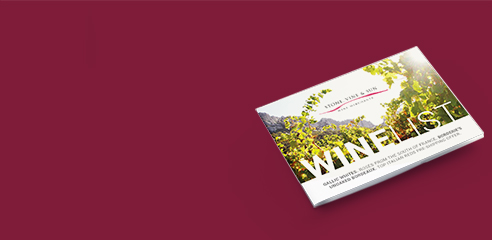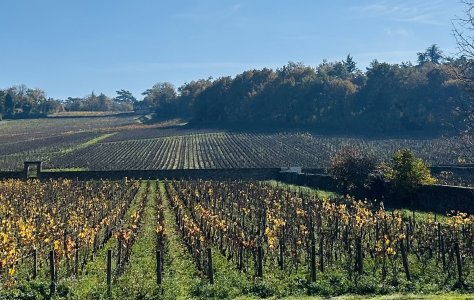Top 8 Wines from the Northern Fringes of Burgundy
17th February 2022
After two short harvests in Burgundy - 2020, reduced by heat and drought - and the disaster of 2021, when the worst frosts since the 1950s cut the crop in half, there just wasn't enough burgundy to meet the growing demand.
So Simon recently embarked on a voyage to discover the best, responsibly priced Burgundy - and he found them in the northern fringes of Burgundy.
Here’s our hand-picked selection of the top 8 Wines from the Northern Fringes of Burgundy:
- Antoine et Laurent Robin, Petit Chablis 2020
- Clotilde Davenne, Bourgogne Aligote 2020
- Clotilde Davenne, Bourgogne Cotes d'Auxerre, Tres Vielles Vignes 2020
- La Croix Montjoie, Vezelay, L’Impatiente, 2020
- La Croix Montjoie, Vezelay, L’ Elegante, 2020
- La Croix Montjoie, Vezelay, La Voluptuese, 2019
- Domaine Ferrari, Irancy, 2019
- Domaine Ferrari, Irancy, Les Mazelots 2019

Antoine et Laurent Robin, Petit Chablis 2020
From vines with an average age of 30-40 years, planted on the Portlandian plateau, a bright and juicy Petit Chablis. “This is an elegant Petit Chablis which balances concentration on the palate with complex flavours, and a great line of acidity keeping everything fresh. Drinking well already, this will keep for 12-18 months. A fine example. 91/100”, Andy Howard, MW, Petit Chablis 2020: top-scoring wines, Decanter, October 2021.
Clotilde Davenne, Bourgogne Aligote 2020
From 85-year-old vines grown on clay-limestone slopes at Les Rosiers near Saint-Bris-le-Vineux, west of Chablis. A classic Aligoté, but with considerable dry heft from those ancient vines: there’s no skin contact but one can almost sense tannin, such is the intensity. Fresh and lemony, this would be perfect to drink with simply prepared whitefish. Rather thrilling. Now-2023
Clotilde Davenne, Bourgogne Cotes d'Auxerre, Tres Vielles Vignes 2020
From St Bris, 75-year-old Chardonnay vines on Kimmeridgian and Portlandian soils yielding a mere 30 hectolitres per hectare. Expansive aromas of lemon and cream with a hint of pine. Mid-weight and refined: has the volume of an oaked wine but is wholly from tank. Plenty of citrus but with an attractive herbal backnote. Essence of unoaked Chardonnay grown on limestone soils. Now-2024.
La Croix Montjoie, Vezelay, L’Impatiente, 2020
From younger vines on the lower slopes (so more clay) near the cellar, all in tank. Lightly floral scent. Nicely textured, ready (no need for patience, as the name implies), with an appealingly fresh finish. Now-2023.
Vézelay is a tiny (about 100 hectares of vines planted out of a possible 250) appellation, created only for Chardonnay in 2017 at the instigation of a dozen quality-minded growers and a small co-operative. Sophie and Thierry Woilez, now with 15 organically farmed hectares around La Croix Montjoie’s cellar in Tharoiseau, a hamlet just south-east of the hilltop town of Vézelay, are among the leaders of that campaign and the appellation. It’s a special landscape, recognised by Unesco, with small fields bordered by hedges, and offering a patchwork of forests, pasture and vines. Chardonnays of elegance and definition.
La Croix Montjoie, Vezelay, L’ Elegante, 2020
From vines near the top of the slope, so over more limestone; about 75% in stainless steel, 25% in three-year-old barrels. This shows the same white floral hints, overlaid by a little creamy oak. It opens out beautifully, displaying ripe citrus, floral aromatics (verbena?) and a stony feel. Very refined and satiny, this could easily be taken for a village Puligny. Airy and elegant indeed. Now-2025.
La Croix Montjoie, Vezelay, La Voluptuese, 2019
From the estate’s oldest vines on a southwest-facing slope, all in barrel, 20% new and the rest mainly first fill, the barrels very lightly toasted. Beautifully opulent tangerine flavours, with splendid ripeness and weight. Perfect for those who like a richer style of barrel-fermented Chardonnay. Honey cut by citrus; and persistent. Now-2025
Domaine Ferrari, Irancy, 2019
Assembled from numerous plots all over the appellation, with about half aged in barrel. Includes about 2% of César, a local grape. Pure perfume of cherries and strawberries – and that combination of the ripeness of black cherries and the freshness of red berries pervades the wine. Lovely fruit intensity all the way to the finish. Really aromatic. Super Pinot at this price. Now-2026
Domaine Ferrari - with son Nicolas taking over from father Christophe, who began buying vineyards around the village in 1987 - is among the leaders in the appellation. Christophe considers 2019 a really special vintage there, offering spectacularly ripe and clean fruit. The style of the wines is traditional Burgundy: full-flavoured and age-worthy. They may not show the finesse of the finest of the Côte d’Or – but they are only a fraction of the price. If you used to buy Gevrey-Chambertin, switched to the Côte de Beaune but can’t afford that anymore, get stuck in.
Domaine Ferrari, Irancy, Les Mazelots 2019
The Ferraris make four other pure Pinots; not single-vineyard wines, but from small plots within different subzones of the appellation. Mazelots is one of the best-regarded of these: marked by stony soils with a high clay content; mid-slope; and facing south in the middle of the vineyard bowl. This shows more power, purity and sophistication than the village Irancy: there’s lots of flesh and vivid fruit - strawberries, blackberries and black plums - plus ripe tannins, good texture and expansive aromatics; but also an appealing freshness and cut to it. This is already drinking well but should develop nicely. Now-2026.
Exclusive to Stone, Vine & Sun
We source our amazing wines from small independent winemakers and as such you’re unlikely to find them anywhere else in the UK.
Due to their exclusivity, these beautiful wines from Northern Burgundy may sell out. If any of our selection of top picks are unavailable, you can get in touch with us & we’d be delighted to suggest some delicious alternatives.
For further insight into Simon's voyage and how he came across these delightful wines, read his blog: The answer - the northern fringes of Burgundy.



